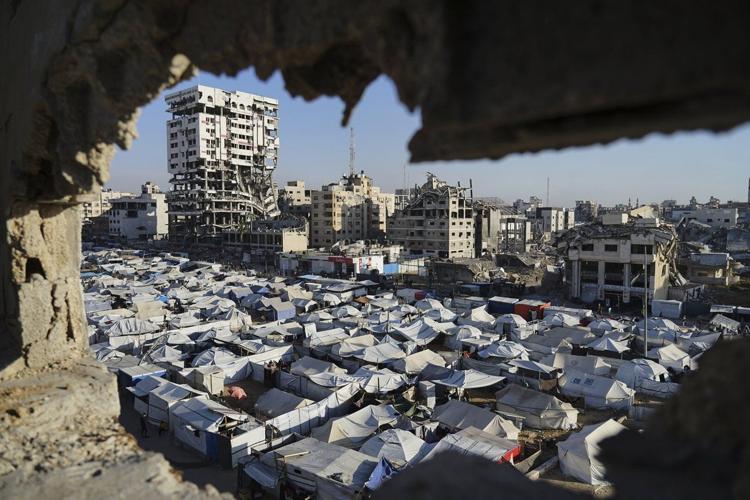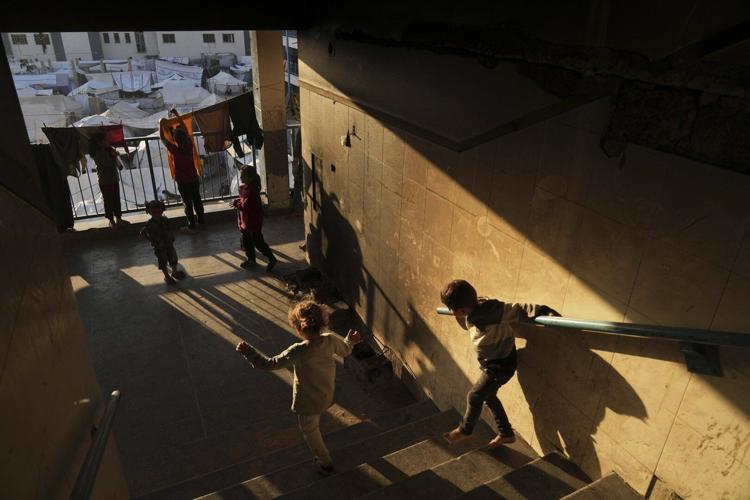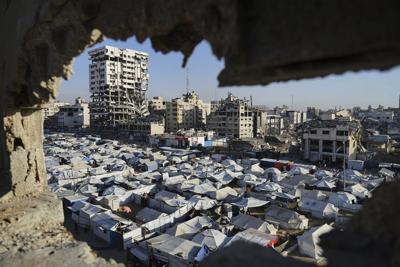TEL AVIV, Israel (AP) ŌĆö A group of American security contractors, ex-military officers and humanitarian aid officials is proposing to take over the distribution of food and other supplies in Gaza based on plans similar to ones designed by Israel.
The Associated Press obtained a proposal from the newly created group, the Gaza Humanitarian Foundation, to implement a new aid distribution system supplanting the current one run by the U.N. and other international aid agencies. The U.N. and aid groups have rejected .
It was not immediately clear if the proposal from the new group, which is registered in Geneva, would ease those concerns.
Israel has and all other supplies from entering Gaza for 10 weeks, worsening a humanitarian crisis for 2.3 million Palestinians. It has said it wonŌĆÖt allow aid back in until a system is in place that gives it control over distribution.
The 14-page proposal circulated this week among aid groups and U.N. officials lays out plans similar to ones Israel has been discussing privately for weeks with international aid groups. The proposal reveals for the first time plans to create the foundation and names the people leading it.
A U.N. official said last week that Israel’s plans would ŌĆ£weaponize aidŌĆØ by placing restrictions on who is eligible to receive it.
Aid workers have also criticized the plans, which would centralize distribution at four hubs under the protection of private security contractors. They say the plans could not possibly meet the needs of , and that they would forcibly displace large numbers of Palestinians by driving them to move nearer to the aid.
Under the new group’s proposal, Palestinians would receive pre-packaged rations, potable water, hygiene kits, blankets, and other supplies at the distribution hubs. The group said it wants to partner with the U.N. and international aid groups in handing out their supplies.
A U.S. official confirmed the authenticity of the proposal and said the former director of the U.N. World Food Program, David Beasley, is the lead choice to run GHF. The proposal could still be revised and BeasleyŌĆÖs role is not confirmed, the official said, speaking on condition of anonymity to detail plans that have not been made public.
Beasley, a former governor of South Carolina, didnŌĆÖt immediately respond to messages seeking comment.
Israel accuses Hamas and other militants of siphoning off large amounts of aid. The U.N and aid workers deny there is significant diversion, saying the U.N. strictly monitors distribution.
When contacted Thursday for comment about GHFŌĆÖs proposal, Israeli officials did not immediately respond.
U.S. backing for the foundation
The Trump administration supports the new group’s proposal, said a person involved in it. The person said GHF would work ŌĆ£within the confinesŌĆØ set by Israel on aid but would be ŌĆ£independent and committed to humanitarian principlesŌĆØ ŌĆö a nod to U.N. concerns. The person spoke on condition of anonymity to discuss a plan not yet made public.
ŌĆ£This is a new approach with one focus: Get help to people. Right now,ŌĆØ said U.S. State Department spokeswoman Tammy Bruce.
Ahead of his first trip to the Middle East this week, U.S. President Donald Trump said ŌĆ£a lot of talkŌĆØ was going on about Gaza and that his administration will soon have more to say about a new proposal. This may include a new push for a , the release of hostages and an influx of aid to Palestinians.
Aryeh Lightstone, a senior member of team, was involved in briefing U.N. agencies and aid groups about the foundation as they gathered in Geneva on Thursday, according to two humanitarian workers briefed on the meeting who spoke on condition of anonymity because they were not authorized to comment to the media.
WhoŌĆÖs involved?
GHF’s proposal names a 10-member leadership team that includes former senior American military officers, business executives and officials from aid groups. At least two of them have ties to private security companies.
Beasley is listed among them, but the proposal says his role is still ŌĆ£to be finalized.ŌĆØ Beasley is also a senior advisor to Fogbow, a private U.S. firm that participated in the short-lived project delivering aid to Gaza by sea via a U.S. military-built pier.
The AP contacted people listed in the proposal to confirm their participation. Only one responded, saying he was ŌĆ£not on the board.ŌĆØ The person involved in planning said the list was still in flux.
How would it work?
According to the proposal, GHF would initially set up four distribution sites, each serving 300,000 people. That would cover about half of GazaŌĆÖs population. The system would be scaled up to meet the needs of 2 million people. But the proposal does not give a timeframe. Aid workers warn that food is rapidly running out in Gaza under IsraelŌĆÖs blockade.
The GHF proposal said subcontractors will use armored vehicles to transport supplies from the Gaza border to distribution sites, where they will also provide security. It said the aim is to deter criminal gangs or militants from redirecting aid.
It did not specify who would provide security but said it could include personnel who previously worked in the Netzarim Corridor, an Israeli-held zone cutting off northern Gaza. A private logistics and operations company, Safe Reach Solutions, has operated in the corridor.
GHF said people will get assistance based on need with no eligibility requirements. This appears to differ from proposals floated by Israel. Aid workers say Israel has said it intends to vet aid recipients and screen them using facial recognition.
What do aid groups say?
Throughout IsraelŌĆÖs campaign in Gaza, the U.N. and other humanitarian groups have been carrying out a massive aid program. They have trucked in supplies and distributed them across the territory, going as close as possible to where Palestinians were located.
What has chiefly hampered the system, aid workers have said, are Israeli military operations and restrictions on movement, as well as the low amount of aid allowed to enter even before the blockade. Convoys have also been attacked by criminal groups stealing aid, and hungry Palestinians have sometimes taken supplies from trucks.
Aid workers contacted by the AP cast doubt whether GHF would meet humanitarian requirements for neutrality and independence.
Shaina Low, communications adviser for Norwegian Refugee Council, one of the main organizations in Gaza, said aid groups are concerned the plan will be used ŌĆ£to advance military and political goals.ŌĆØ
By forcing the population to relocate around aid hubs, the system would ŌĆ£depopulate entire parts of GazaŌĆØ and could be used to potentially expel the population, she said.
ŌĆ£They are framing (the plan) to fix the problem that doesnŌĆÖt really exist,” she said, referring to IsraelŌĆÖs contention that it must prevent Hamas from taking aid.
The use of private security companies has also alarmed humanitarian workers. While itŌĆÖs common for private security firms to operate in conflict zones, they have to respect humanitarian law and at a minimum be fully vetted and monitored, said Jamie Williamson, executive director for the International Code of Conduct Association.
Tamara Alrifai, communications director for the U.N. agency for Palestinian refugees, which has led the aid effort it Gaza, said the plan was logistically unworkable.
She said the foundation does not appear able to match the current infrastructure needed to distribute food and address other humanitarian needs.
Alrifai called it ŌĆ£a very dangerous precedent” for countries to use ŌĆ£full siege as a tactic of warŌĆØ to force the abandonment of ŌĆ£existing aid structures and the entire international system that exists and is recognized and start creating a new system.ŌĆØ
___
El Deeb reported from Beirut. AP reporters Matthew Lee in Washington, Farnoush Amiri at the United Nations, Meg Kinnard in Chapin, South Carolina, and Jamey Keaten in Geneva contributed to this report.






























